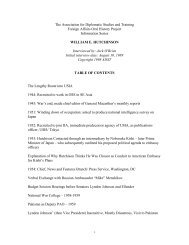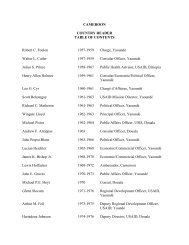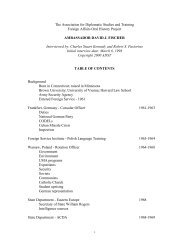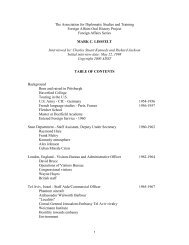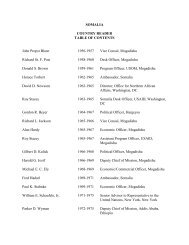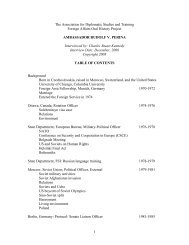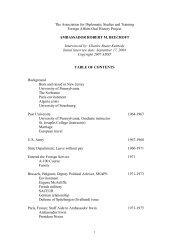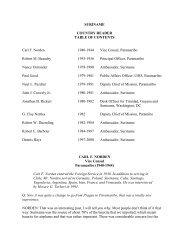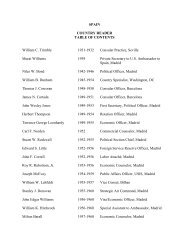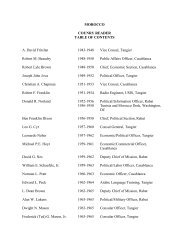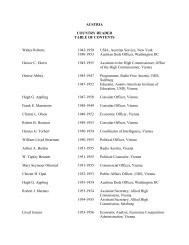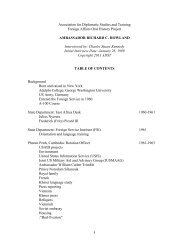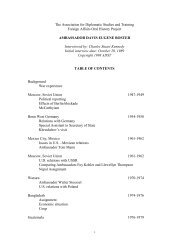1 The Association for Diplomatic Studies and Training Foreign ...
1 The Association for Diplomatic Studies and Training Foreign ...
1 The Association for Diplomatic Studies and Training Foreign ...
Create successful ePaper yourself
Turn your PDF publications into a flip-book with our unique Google optimized e-Paper software.
When I was in Iran, the Peace Corps had put in place a very large program. It was a good<br />
one. It worked in the villages, on education, health <strong>and</strong> water supply. <strong>The</strong> Peace Corps<br />
had a very big group that worked on teaching in the villages. Literacy corps activity, by<br />
the Iranians <strong>and</strong> other village work by the Peace Corps made it possible to extend<br />
education to villages where it was not possible be<strong>for</strong>e. It should be noted that in almost<br />
all villages of Iran no matter how remote, there was a mullah. He would teach at the<br />
village school – called maktabs – <strong>for</strong> three grades. <strong>The</strong>y taught the Koran, the great<br />
Persian poets, <strong>and</strong> used whatever literary materials were available. <strong>The</strong> idea of village<br />
education was something that was built into the Iranian system. What the modern world<br />
brought, with the shah’s so-called literacy corps <strong>and</strong> programs like the American Peace<br />
Corps, accompanying that, which were much smaller in number of course compared to<br />
the tens of thous<strong>and</strong>s of teaching mullahs, was a new dimension. <strong>The</strong> literacy corps <strong>and</strong><br />
the Peace Corps teachers extended <strong>and</strong> modernized, meaning secularized, what had been<br />
a traditional <strong>for</strong>m of basic literacy that had a strong religious content. As I think about it<br />
now, the roots of religious life throughout the country really was reflected in the role of<br />
the mullah in the village. <strong>The</strong> mullah per<strong>for</strong>med marriages. He taught. He buried the<br />
dead. <strong>The</strong> mullahs were a key part of the social structure of villages <strong>and</strong> cities that had<br />
existed <strong>for</strong> a very long time. I suppose if one did careful research you could go back<br />
be<strong>for</strong>e Islam <strong>and</strong> you would have found that Zoroastrian priests carried out these<br />
necessary social functions.<br />
Q: Under the shah’s regime, were they able to tap a resource to bring about further<br />
education of having young, educated Iranians going out to the people, sort of like<br />
Narodniki? I mean, of that type?<br />
MILLER: Well, that was the way the literacy corps per<strong>for</strong>med. That was characteristic of<br />
the most successful programs. <strong>The</strong> literacy corps was a program whereby young Iranian<br />
university graduates, <strong>and</strong> high school graduates, went out to the villages <strong>and</strong> taught. In<br />
other words, those who were going into education as a profession in the Ministry of<br />
Education – that was the sole employer of teachers, <strong>and</strong> a h<strong>and</strong>ful of very few private<br />
schools – they went out into the villages as part of their training. Just as our doctors here<br />
under the medical student support programs the Congress has m<strong>and</strong>ated, are given free<br />
education <strong>for</strong> medical training, then the doctors were obligated to serve <strong>for</strong> several years<br />
in public health. So the Iranian student teachers went out to the villages as secular,<br />
modernizing missionaries.<br />
Most of the teachers were urban, from the big cities. <strong>The</strong>y had never really experienced or<br />
seen real life in the villages. <strong>The</strong>y became socialized when they saw, at first h<strong>and</strong>,<br />
realities of Iran. Many of the literacy corps became revolutionaries later. <strong>The</strong>y saw the<br />
needs of the country first h<strong>and</strong>. It was part of the process of what we could call, Iran’s<br />
democratization. <strong>The</strong> country was meeting itself on its own terms <strong>and</strong> seeing what its<br />
needs were <strong>and</strong> responding. <strong>The</strong> literacy corps, the medical corps, those infrastructure<br />
kinds of approaches that were in the so-called White Revolution but were also planned<br />
<strong>for</strong> in the Plan Organization objectives of the time of what was needed <strong>for</strong> Iran to become<br />
66




